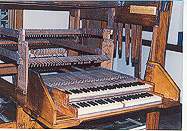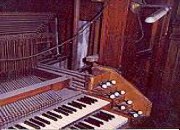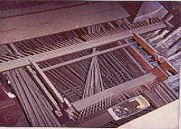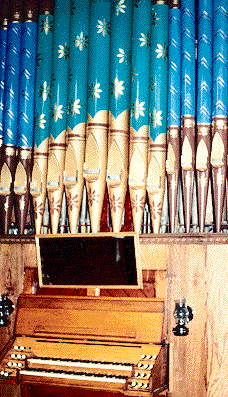This page is dedicated to the memory of Father Thomas Schirmer, late Rector of St. Andrew's Episcopal Church, without his love of music, the restoration of the Mandeville Organ would not have been possible.
Welcome to Universal Restorations | About Us | The Mandeville Organ | The Morey Organ | The Never Ending Project | The Essex Chapel Project | Organ Gallery | Work In Progress | Decorative Facades | Anything Can Be Fixed | Products and Services | Links | Contact Us | Guest Book
 |
 |
 |
This 17 rank mechanical action pipe organ was originally constructed by brothers William and James Mandeville in 1886 for an Episcopalian mission then know as Christ Chapel, in the Redhook section of Brooklyn, N.Y.
The Mandeville brothers were employed chiefly as pipe builders who supplied organ pipes to other organ builders, however they were responsible for the construction of 15 - 17 instruments of their own. The one pictured here is the only known extant example of their organ building work.
The Mandeville organ served Christ Chapel, which later became the Church of the Holy Child Jesus until the early 1970's when it and the congregation at Redhook, both long ailing, fell silent.
In 1996 the church building that housed the organ was slated for sale by the Episcopal diocese to another denomination. The organ was not part of the sale. It was decided that the organ should - hearkening back to it's original use a century earlier - be given to another mission church, namely St. Andrews in Astoria, NY. The Rector of St. Andrews was thrilled with the decision, except of course that he was now left with the dilemma of how to move an organ across the City of New York, and what to do with it once he got it to his church.
Universal Restorations, then L.O.S. Corp. intervened by offering to dismantle the organ in Redhook, catalog the components, move the instrument to storage in Astoria, and finally reassemble and restore the organ when funds had been raised.
On Independence Day of 1996, the painstaking work of reassembling the organ began. There were a number of obstacles to surmount -- Holy Child Jesus was roughly four times larger than St. Andrew's. The Organ was originally 27 feet tall. The apex of St. Andrew's A-frame roof is 24 feet from floor to ceiling. In addition, the organ had to be moved without the case, as the new occupants considered the organ case part of the architectural beauty of their new church, and would not close the deal if the case - decidedly beautiful and constructed entirely of dark Mahogany, were removed. A further technical challenge was presented in the pedal division, which had been converted at some time during the teen years of the twentieth century to tubular pneumatic action. Needless to say, this unreliable action had long since ceased to function. Most of the reed pipes had been destroyed, and many toe boards were rotting through.
By August, the organ's frame work had been redesigned, new tracker rods for the action cut, other defunct components had been refabricated, the pedal division restored to original mechanical action and a simple oak case planned.
Complete in its new location, the Mandeville organ was heard for the first time in three decades, in November of 1996, in a dedicatory recital played by Mark LaMort, the company's founder.
The tone of the organ hearkens to that of English pipe organs of the mid nineteenth century - being light and quick of speech and full of nuance.
The central visual beauty of the instrument comes from the painted pipe facade, the design and choice of color being typical of that employed on American organs of the "Victorian" era. The original bench, mahogany fall board, and functional oil lamp sconces add to the instrument's authenticity.
Winding is by the original single rise bellows and is at 2 and one half inches of water displacement.
Specifications:
 Great
Open Diapasons 8'
Melodia 8'
Keralanophone 8'
Principal 4'
Flute 4'
Piccolo 2'
Trumpet 8'
Swell
Bourdon 16'
Geigen Diapason 8'
Stopped Diapason 8
Dulciana 8'
Violina 4'
Oboe 8'
Cornet III
Pedal
Subbass 16
|
Pipe Organ 101 (sort of) | Our Philosophy of Organ Tuning | The Physics of the Organ | How an Organ is tuned | Harmoniums and Reed Organs | Carillons | Harpsichords